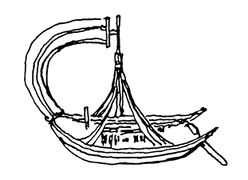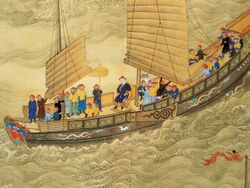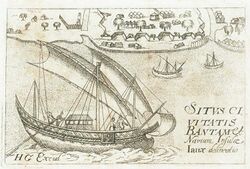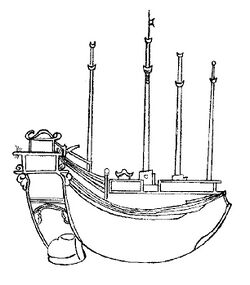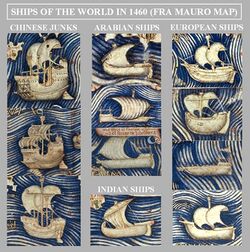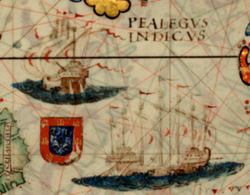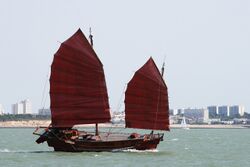Engineering:Junk (ship)
A junk (Chinese: 船, chuán) is a type of China sailing ship with fully battened sails. There are two types of junk in China: northern junk, which developed from Chinese river boats,[1]:20 and southern junk, which developed from Austronesian ships visiting southern Chinese coasts since the 3rd century CE. They continued to evolve in later dynasties and were predominantly used by Chinese traders throughout Southeast Asia. Similar junk sails were also adopted by other East Asian countries, most notably Japan, where junks were used as merchant ships to trade goods with China and Southeast Asia. They were found – and in lesser numbers, are still found – throughout Southeast Asia and India, but primarily in China.[2] Historically, a Chinese junk could be one of many types of small coastal or river ships, usually serving as a cargo ship, pleasure boat, or houseboat, but also ranging in size up to large ocean-going vessel. Found more broadly today is a growing number of modern recreational junk-rigged sailboats. There can be significant regional variations in the type of rig or the layout of the vessel; however, they all employ fully battened sails.
The term "junk" (Portuguese junco; Dutch jonk; and Spanish junco)[3] was also used in the colonial period to refer to any medium- to large-sized ships of the Austronesian cultures in Island Southeast Asia, with or without the junk rig.[4] Examples include the Indonesian and Malaysian jong, the Philippine karakoa and lanong, and the Moluccan kora kora.[5]
Etymology
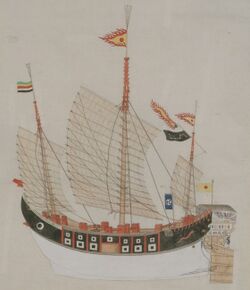
The English word "junk" comes from Portuguese junco from Javanese jong and ultimately from Min Chinese jüng (船, "boat; ship").[6]
Construction
The historian Herbert Warington Smyth considered the junk as one of the most efficient ship designs, stating that "As an engine for carrying man and his commerce upon the high and stormy seas as well as on the vast inland waterways, it is doubtful if any class of vessel… is more suited or better adapted to its purpose than the Chinese or Indian junk, and it is certain that for flatness of sail and handiness, the Chinese rig is unsurpassed".[7]
Sails
Iconographic remains show that Chinese ships before the 12th century used square sails. A ship carving from a stone Buddhist stele shows a ship with square sail from the Liu Sung dynasty or the Liang dynasty (ca. 5th or 6th century). Dunhuang cave temple no. 45 (from the 8th or 9th century) features large sailboats and sampans with inflated square sails. A wide ship with a single sail is depicted in the Xi'an mirror (after the 9th or 12th century).[8][9] Eastern lug sail, which used battens and is commonly known as "junk rig", was likely not Chinese in origin: The oldest depiction of a battened junk sail comes from the Bayon temple at Angkor Thom, Cambodia.[10]:460-461 From its characteristics and location, it is likely that the ship depicted in Bayon was a Southeast Asian ship.[11]:188-189 The Chinese themselves may have adopted them around the 12th century CE.[1]:21
The full-length battens of the junk sail keep the sail flatter than ideal in all wind conditions. Consequently, their ability to sail close to the wind is poorer than other fore-and-aft rigs.[12][13]
Hull
Classic junks were built of softwoods (although after the 17th century teak was used in Guangdong) with the outside shape built first. Then multiple internal compartment/bulkheads accessed by separate hatches and ladders, reminiscent of the interior structure of bamboo, were built in. Traditionally, the hull has a horseshoe-shaped stern supporting a high poop deck. The bottom is flat in a river junk with no keel (similar to a sampan), so that the boat relies on a daggerboard,[14] leeboard or very large rudder to prevent the boat from slipping sideways in the water.[15]
The internal bulkheads are characteristic of junks, providing interior compartments and strengthening the ship. They also controlled flooding in case of holing. Ships built in this manner were written of in Zhu Yu's book Pingzhou Table Talks, published by 1119 during the Song dynasty.[9] Again, this type of construction for Chinese ship hulls was attested to by the Moroccan Muslim Berber traveler Ibn Battuta (1304–1377 CE), who described it in great detail (refer to Technology of the Song dynasty).[16]
Benjamin Franklin wrote in a 1787 letter on the project of mail packets between the United States and France:
As these vessels are not to be laden with goods, their holds may without inconvenience be divided into separate apartments, after the Chinese manner, and each of these apartments caulked tight so as to keep out water.—Benjamin Franklin, 1787[17]
Similar wet wells were also apparent in Roman small craft of the 5th century CE.[18]
Leeboards and centerboards
Other innovations included the square-pallet bilge pump, which was adopted by the West during the 16th century for work ashore, the western chain pump, which was adopted for shipboard use, being of a different derivation. Junks also relied on the compass for navigational purposes. However, as with almost all vessels of any culture before the late 19th century, the accuracy of magnetic compasses aboard ship, whether from a failure to understand deviation (the magnetism of the ship's iron fastenings) or poor design of the compass card (the standard drypoint compasses were extremely unstable), meant that they did little to contribute to the accuracy of navigation by dead reckoning. Indeed, a review of the evidence shows that the Chinese embarked magnetic pointer was probably little used for navigation. The reasoning is simple. Chinese mariners were as able as any and, had they needed a compass to navigate, they would have been aware of the almost random directional qualities when used at sea of the water bowl compass they used. Yet that design remained unchanged for some half a millennium. Western sailors, coming upon a similar water bowl design (no evidence as to how has yet emerged) very rapidly adapted it in a series of significant changes such that within roughly a century the water bowl had given way to the dry pivot, a rotating compass card a century later, a lubberline a generation later and gimbals seventy or eighty years after that. These were necessary because in the more adverse climatic context of north western Europe, the compass was needed for navigation. Had similar needs been felt in China, Chinese mariners would also have come up with fixes.[19]
Steering
Junks employed stern-mounted rudders centuries before their adoption in the West for the simple reason that Western hull forms, with their pointed sterns, obviated a centreline steering system until technical developments in Scandinavia created the first, iron mounted, pintle and gudgeon 'barn door' western examples in the early 12th century CE. A second reason for this slow development was that the side rudders in use were still extremely efficient.[20] Thus the junk rudder's origin, form and construction was completely different in that it was the development of a centrally mounted stern steering oar, examples of which can also be seen in Middle Kingdom (c. 2050–1800 BCE) Egyptian river vessels. It was an innovation which permitted the steering of large ships and due to its design allowed height adjustment according to the depth of the water and to avoid serious damage should the junk ground. A sizable junk can have a rudder that needed up to twenty members of the crew to control in strong weather. In addition to using the sail plan to balance the junk and take the strain off the hard to operate and mechanically weakly attached rudder, some junks were also equipped with leeboards or dagger boards. The world's oldest known depiction of a stern-mounted rudder can be seen on a pottery model of a junk dating from before the 1st century CE.[21]
History
Spring and Autumn period (8th–5th century BCE)
Mariners were sailing between islands to cross the Shandong-Liaodong strait and along the Korean coastline by the 8th century BCE. In 710 BCE, due to a famine in Korea, ships sailed to the state of Lu and Qi in Shandong to purchase grain. In 656 BCE, Qi planned a naval invasion of Chu. River traversal by ship was recorded during the Chu-Wu wars in 603 BCE and 549 BCE. A river battle between the two fleets of Chu and Wu occurred in 525 BCE and lost their flagship Yuhuang.[22] According to a poem by Ma Rong 600 years later, the Yuhuang was equipped with sails: "From the Yuhuang to the small boats, all unfurled sails like clouds and displayed awnings like rainbow."[23] Prior to the 12th century, Chinese sails were commonly made of bamboo mats since cotton did not become common in China until the Song–Yuan dynasties.[23] There were reports of Chu building fleets in 528 BCE and 518 BCE but Chu was defeated by Wu's fleet in 489 BCE, and their admiral and seven officers were captured.[22] In 485 BCE, Wu's fleet sailed up the coast to attack Qi and was defeated in the first known naval battle in Chinese history. In 478 BCE, Yue's fleet destroyed Wu's navy.[24]
Warring States and Qin period (5th–3rd century BCE)
Because of fables that there were islands to the east that possessed the elixir of immortality, King Wei of Qi (r. 356–320 BCE), King Xuan of Qi (r. 319–301 BCE), and King Zhao of Yan (r. 311–279 BCE) sent naval expeditions to search for them. They failed. In the Qin dynasty, a magician named Xu Shi from the former state of Qi requested help to organize an expedition to seek the immortal islands of Penglai, Fangzhang, and Yingzhou. Three thousand young men and women and "artisans of a hundred trades"[25] set sail from Langya in 219 BCE. No news returned of Xu Shi, so Qin Shi Huang sent another expedition with four magicians in 215 BCE. Only one magician named Scholar Lu came back and he deserted in 212 BCE. In 210 BCE, the emperor met Xu Shi, who had failed to bring back the elixir of immortality. He said that the expedition had been frustrated by dragons and sea monsters. They set out with a squadron of crossbowmen and cruised around the Shandong peninsula, where they killed a large fish at Zhifu.[26]
Han to Northern and southern dynasties era (2nd–6th century)
The Chinese engaged in cross-ocean expeditions by the 2nd century BCE.[27] In 108 BCE, Yang Pu led a sea-force to Korea.[28] The Book of Han mentions sea-going voyages taking 12 months to reach the furthest country.[29] In 230, Sun Quan sent commanders Wei Wen and Zhuge Zhi with a fleet of 10,000 men to seek the islands of Yizhou and Danzhou. The fleet was away for a year and many of the crew died of disease. It did not reach Danzhou but reached Yizhou and returned with several thousand captives. The contemporary writer Shen Ying stated that Yizhou was 2,000 li southeast of Linhai and appears to have been Taiwan. Danzhou was probably the Ryukyu Islands.[30] In 233 CE, a fleet from Eastern Wu was lost in a storm in the Yellow Sea.[31]
Manguin, Pelliot, Ferrand, Miksic, and Flecker, amongst other, believe that the ships used by Chinese travelers were mostly foreign in origin, and Chinese ships were rarely used on the Southeast Asian voyages until the 9th century CE.[32]:20-21 Chinese ships did exist – but they're essentially fluvial (riverine) in nature and operation.[1]:20 Large Austronesian trading ships docking in Chinese seaports with as many as four sails were recorded by scholars as early as the 3rd century CE. They called them the kunlun bo or kunlun po (崑崙舶, lit. "ship of the Kunlun people"). They were booked by Chinese Buddhist pilgrims for passage to Southern India and Sri Lanka.[33]:275[34]:32–33[35]:34–36
The 3rd century book Strange Things of the South (南州異物志, Nánzhōu Yìwùzhì) by Wan Chen (萬震) describes one of these Austronesian ships as being capable of 600–700 people together with more than 10,000 hu (斛) of cargo (250–1000 tons according to various interpretations—600 tons deadweight according to Manguin).[36]:262 The ships could be more than 50 meters in length and had a freeboard of 5.2–7.8 meters. When seen from above they resemble covered galleries.[37]:347 He explains the ships' sail design as follows:
The people beyond the barriers, according the size of their ships, sometimes rig (as many as) four sails which they carry in row from bow to stern. (...) The four sails do not face directly forward, but are set obliquely, and so arranged that they can all be fixed in the same direction, to receive the wind and to spill it. Those sails which are behind the most windward one receiving the pressure of the wind, throw it from one to the other, so that they all profit from its force. If it is violent, (the sailors) diminish or augment the surface of the sails according to the conditions. This oblique rig, which permits the sails to receive from one another the breath of the wind, obviates the anxiety attendant upon having high masts. Thus these ships sail without avoiding strong winds and dashing waves, by the aid of which they can make great speed.—Wan Chen
A 260 CE book by K'ang T'ai (康泰), quoted in Taiping Yulan (982 CE) described ships with seven sails called po or ta po (great ship or great junk) that could travel as far as Syria (大秦—Ta-chin, Roman Syria). These ships were used by the Indo-Scythian (月支—Yuezhi) traders for transporting horses. He also made reference to monsoon trade between the islands (or archipelago), which took a month and a few days in a large po.[37]:347[10]:602[38]:406
Sui to the rise of Song dynasty (7th century–10th century)
In 683 CE, Tang court sent an envoy to Srivijaya, which seems to have been done in foreign ship.[32]:22 Wang Gungwu stated that there are no records from Tang Dynasty era that mentioned Chinese junks being used for trading with Southern countries (Nanhai).[39]:107 Wang also noted that the ships used by Chinese pilgrim and travelers were K'un-lun ships or Indian ships.[39]:73, 103 Chinese and Korean ships sailed to Kyushu for private trade with Japan in the 9th century.[32]:21
Southern Chinese junks were based on keeled and multi-planked Austronesian ships (known as po by the Chinese, from the Old Javanese parahu,[40]:1280 Javanese prau, or Malay perahu – large ship).[41]:613[42]:193[43]:21 Southern Chinese junks showed characteristics of Austronesian ships that they are made using timbers of tropical origin, with keeled, V-shaped hull. This is different from northern Chinese junks, which are developed from flat-bottomed riverine boats.[1]:20–21 The northern Chinese junks were primarily built of pine or fir wood, had flat bottoms with no keel, water-tight bulkheads with no frames, transom (squared) stern and stem, and have their planks fastened with iron nails or clamps.[41]:612-614
It was unknown when the Chinese people started adopting Southeast Asian (Austronesian) shipbuilding techniques. They may have been started as early as the 8th century, but the development was gradual and the true ocean-going Chinese junks did not appear suddenly.[33]:276[44]:200[45]:83 The word "po" survived in Chinese long after, referring to the large ocean-going junks.[33]:274
Song dynasty (10th–13th century)
In 989 CE the Song court permitted private Chinese ships to trade overseas.[32]:21 The ships of the Song, both mercantile and military, became the backbone of the navy of the following Yuan dynasty. In particular the Mongol invasions of Japan (1274–1281), as well as the Mongol invasion of Java (1293), essentially relied on recently acquired Song naval capabilities. Worcester estimates that the largest Yuan junks were 36 feet (10.97 m) in width and over 100 feet (30.48 m) long. In general, they had no keel, stempost, or sternpost. They did have centreboards, and a watertight bulkhead to strengthen the hull, which added great weight. This type of vessel may have been common in the 13th century.[46]:22[47]:102 By using the ratio between the number of soldiers and ships, Nugroho concluded that each ship may carry a maximum capacity of 30 or 31 men,[48]:128 while using data presented by John Man would result in a capacity of 29–44 men per ship.[49]:306 David Bade estimated a capacity of 20 to 50 men per ship during the Java campaign.[50]:46
Yuan dynasty (14th century)
Yuan dynasty ships carry on the tradition of Song, the Yuan navy is essentially Song navy.[51] Both Song and Yuan employed large trading junks. The large ships (up to 5,000 liao or 1520–1860 tons burden) would carry 500–600 men, and the second class (1,000–2,000 liao) would carry 200–300 men.[52] Unlike Ming treasure ships, Song and Yuan great junks are propelled by oars, and have with them smaller junks, probably for maneuvering aids.[53] The largest junks (5,000 liao) may have a hull length twice that of Quanzhou ship (1,000 liao),[54] that is 68 metres (223.1 ft).[52] However, the usual Chinese trading junks pre-1500 was around 20–30 metres (65.6–98.4 ft) long, with the length of 30 metres (98.4 ft) only becoming the norm after 1500 CE. Large size could be a disadvantage for shallow harbors of southern seas, and the presence of numerous reefs exacerbates this.[55]
The enormous dimensions of the Chinese ships of the Medieval period are described in Chinese sources, and are confirmed by Western travelers to the east, such as Marco Polo, Ibn Battuta and Niccolò da Conti. According to Ibn Battuta, who visited China in 1347:
…We stopped in the port of Calicut, in which there were at the time thirteen Chinese vessels, and disembarked. On the China Sea traveling is done in Chinese ships only, so we shall describe their arrangements. The Chinese vessels are of three kinds; large ships called chunks (junks), middle sized ones called zaws (dhows) and the small ones kakams. The large ships have anything from twelve down to three sails, which are made of bamboo rods plaited into mats. They are never lowered, but turned according to the direction of the wind; at anchor they are left floating in the wind. A ship carries a complement of a thousand men, six hundred of whom are sailors and four hundred men-at-arms, including archers, men with shields and crossbows, who throw naphtha. Three smaller ones, the "half", the "third" and the "quarter", accompany each large vessel. These vessels are built in the towns of Zaytun (a.k.a. Zaitun; today's Quanzhou; 刺桐) and Sin-Kalan. The vessel has four decks and contains rooms, cabins, and saloons for merchants; a cabin has chambers and a lavatory, and can be locked by its occupants. This is the manner after which they are made; two (parallel) walls of very thick wooden (planking) are raised and across the space between them are placed very thick planks (the bulkheads) secured longitudinally and transversely by means of large nails, each three ells in length. When these walls have thus been built the lower deck is fitted in and the ship is launched before the upper works are finished.[56]
—Ibn Battuta
Ming dynasty (15th–17th century)
Expedition of Zheng He
The largest junks ever built were possibly those of Admiral Zheng He, for his expeditions in the Indian Ocean (1405 to 1433), although this is disputed as no contemporary records of the sizes of Zheng He's ships are known. Instead the dimensions are based on Sanbao Taijian Xia Xiyang Ji Tongsu Yanyi (Eunuch Sanbao Western Records Popular Romance, published 1597), a romanticized version of the voyages written by Luo Maodeng nearly two centuries later.[57] Maodeng's novel describes Zheng He's ships as follows:[58][59]
- "Treasure ships" (宝船, Bǎo Chuán) nine-masted, 44.4 by 18 zhang, about 127 metres (417 feet) long and 52 metres (171 feet) wide.
- Equine ships (馬船, Mǎ Chuán), carrying horses and tribute goods and repair material for the fleet, eight-masted, 37 by 15 zhang, about 103 m (338 ft) long and 42 m (138 ft) wide.
- Supply ships (粮船, Liáng Chuán), containing staple for the crew, seven-masted, 28 by 12 zhang, about 78 m (256 ft) long and 35 m (115 ft) wide.
- Transport ships (坐船, Zuò Chuán), six-masted, 24 by 9.4 zhang, about 67 m (220 ft) long and 25 m (82 ft) wide.
- Warships (战船, Zhàn Chuán), five-masted, 18 by 6.8 zhang, about 50 m (160 ft) long.
Louise Levathes suggests that the actual length of the biggest treasure ships may have been between 390–408 feet (119–124 m) long and 160–166 feet (49–51 m) wide.[60] Modern scholars have argued on engineering grounds that it is highly unlikely that Zheng He's ship was 450 ft in length,[61] Guan Jincheng (1947) proposed a much more modest size of 20 zhang long by 2.4 zhang wide (204 ft by 25.5 ft or 62.2 m by 7.8 m)[62] while Xin Yuan'ou (2002) put them as 61–76 m (200–250 feet) in length.[63] Zhao Zhigang claimed that he has solved the debate of the size difference, and stated that Zheng He's largest ship was about 70 m (230 ft) in length.[64]
Comparing to other Ming records, the Chinese seem to have exaggerated their dimensions. European East Indiamen and galleons were said to be 30, 40, 50, and 60 zhang (90, 120, 150, and 180 m) in length.[65][66] It was not until the mid to late 19th century that the length of the largest western wooden ship began to exceed 100 meters, even this was done using modern industrial tools and iron parts.[67][68][69]
Sea ban
From the mid-15th to early 16th century, all Chinese maritime trading was banned under the Ming Dynasty. The shipping and shipbuilding knowledge acquired during the Song and Yuan dynasties gradually declined during this period.[70]
Accounts of medieval travellers
Niccolò da Conti in relating his travels in Asia between 1419 and 1444, describes huge junks of about 2,000 tons in weight:
They build some ships much larger than ours, capable of containing 2,000 tons in size, with five sails and as many masts. The lower part is constructed with of three planks, in order to withstand the force of the tempest to which they are much exposed. But some ships are built in compartments, that should one part is shattered, the other portion remaining intact to accomplish the voyage.[71]
- Other translations of the passage give the size as 2000 butts,[72] which would be around 1000 tons, a butt being half a ton.[lower-alpha 1] Christopher Wake noted that the transcription of the unit is actually vegetes, that is Venetian butt, and estimated a burthen of 1300 tons.[73] The ship of Conti may have been a Burmese or Indonesian jong.[74]
Also, in 1456, the Fra Mauro map described the presence of junks in the Indian Ocean as well as their construction:
The ships called junks (lit. "Zonchi") that navigate these seas carry four masts or more, some of which can be raised or lowered, and have 40 to 60 cabins for the merchants and only one tiller. They can navigate without a compass, because they have an astrologer, who stands on the side and, with an astrolabe in hand, gives orders to the navigator.—Text from the Fra Mauro map, 09-P25, [75]
Fra Mauro further explains that one of these junks rounded the Cape of Good Hope and travelled far into the Atlantic Ocean, in 1420:
About the year of Our Lord 1420 a ship, what is called an Indian Zoncho, on a crossing of the Sea of India towards the "Isle of Men and Women", was diverted beyond the "Cape of Diab" (Shown as the Cape of Good Hope on the map), through the "Green Isles" (lit. "isole uerde", Cabo Verde Islands), out into the "Sea of Darkness" (Atlantic Ocean) on a way west and southwest. Nothing but air and water was seen for 40 days and by their reckoning they ran 2,000 miles and fortune deserted them. When the stress of the weather had subsided they made the return to the said "Cape of Diab" in 70 days and drawing near to the shore to supply their wants the sailors saw the egg of a bird called roc, which egg is as big as an amphora.—Text from Fra Mauro map, 10-A13, [76]
Javanese junk
Javanese junks differed from Chinese junks in several respects. The Javanese junk was made of very thick wood, and as the ship got old, it was fixed with new planks, this way they have 3–4 planks, stacked together. The rope and the sail were made with woven rattan.[77]:191–192[78] The jong was made using jati wood (teak) at the time of this report (1515), at that time Chinese junks are using softwood as the main material.[79]:145 The Javanese ship's hull is formed by joining planks and keel by wooden dowels and treenails, without using iron bolts or nails. Frame would be built later, after the planking (the "shell first" construction). The planks are perforated by an auger and inserted with dowels, which remain inside the fastened planks, not seen from the outside.[33]:267-268[80]:612[81]:138 The hull was pointed at both ends, they carried two rudders and used tanja sail, but it may also use junk sail.[82]:37 It differed markedly from the Chinese vessel, which had its hull fastened by iron nails and strakes to a frame and to bulkheads. The Chinese vessel had a single rudder on a transom stern, and (except in Fujian and Guangdong) they had flat bottoms without keels.[83]:58 The empire of Majapahit used a very large version of these ships, built in north Java, for transporting troops overseas.[84]
Encounters with giant jongs were recorded by Western travelers. Florentine merchant Giovanni da Empoli (1483–1517), one of the first Italian agents to join a Portuguese armada to India in 1503–1504,[85] said that the junks of Java were no different in their strength than a castle, because the three and four boards, layered one above the other, could not be harmed with artillery. They sailed with their women, children, and families, with everyone mainly keeping to their respective rooms.[86]:58 Portuguese recorded at least two encounters with large jongs, one was encountered off the coast of Pacem (Samudera Pasai Sultanate) and the other was owned by Pati Unus, who went on to attack Malacca in 1513.[87]:62–64[88] Characteristics of the 2 ships were similar, both were larger than Portuguese ship, built with multiple plankings, resistant to cannon fire, and had two oar-like rudders on the side of the ship. At least Pati Unus' jong was equipped with three layers of sheathing which the Portuguese said over one cruzado[lower-alpha 2] in thickness each.[79]:151–152 The Chinese banned foreign ships from entering Guangzhou, fearing the Javanese or Malay junks would attack and capture the city, because it is said that one of these junk would rout twenty Chinese junks.[79]:122–123
The main production location of jong was mainly constructed in two major shipbuilding centers around Java: north coastal Java, especially around Rembang–Demak (along the Muria strait) and Cirebon; and the south coast of Borneo (Banjarmasin) and adjacent islands; built by the Javanese. These places have teak forests, whose wood is resistant to shipworm, whereas Borneo itself would supply ironwood.[89]:132[33]:272[90]:377 The Mon people of Pegu also produced jong using Burmese teak.[91]:42, 282
While the Malays of Malacca of the 16th century owned jongs, they were not built by the Malay people or by the Sultanate of Malacca. Malacca only produces small vessels, not large vessels. Large shipbuilding industry does not exist in Malacca – their industry is not capable producing deep-sea ships; only small, light, fast-sailing vessels. The people of Malacca purchased big ships (jong) from other parts of Southeast Asia, namely from Java and Pegu, they did not built them.[92]:250[93]:39[94]:124[95]
Capture of Taiwan
In 1661, a naval fleet of 400 junks and 25,000 men led by the Ming loyalist Zheng Chenggong (Cheng Ch'eng-kung in Wade–Giles, known in the West as Koxinga), arrived in Taiwan to oust the Dutch from Zeelandia. Following a nine-month siege, Cheng captured the Dutch fortress Fort Zeelandia. A peace treaty between Koxinga and the Dutch Government was signed at Castle Zeelandia on February 1, 1662, and Taiwan became Koxinga's base for the Kingdom of Tungning.
Qing dynasty (19th century)
Large, ocean-going junks played a key role in Asian trade until the 19th century. One of these junks, Keying, sailed from China around the Cape of Good Hope to the United States and England between 1846 and 1848. Many junks were fitted out with carronades and other weapons for naval or piratical uses. These vessels were typically called "war junks" or "armed junks" by Western navies which began entering the region more frequently in the 18th century. The British, Americans and French fought several naval battles with war junks in the 19th century, during the First Opium War, Second Opium War and in between.
At sea, junk sailors co-operated with their Western counterparts. For example, in 1870 survivors of the English barque Humberstone shipwrecked off Formosa, were rescued by a junk and landed safely in Macao.[96]
Modern period (20th century)

In 1938, E. Allen Petersen escaped the advancing Japanese armies by sailing a 36-foot (11 m) junk, Hummel Hummel, from Shanghai to California with his wife Tani and two White Russians (Tsar loyalists).[97]
In 1955, six young men sailed a Ming dynasty-style junk from Taiwan to San Francisco. The four-month journey aboard the Free China was captured on film and their arrival into San Francisco made international front-page news. The five Chinese-born friends saw an advertisement for an international trans-Atlantic yacht race, and jumped at the opportunity for adventure. They were joined by the then US Vice-Consul to China, who was tasked with capturing the journey on film. Enduring typhoons and mishaps, the crew, having never sailed a century-old junk before, learned along the way. The crew included Reno Chen, Paul Chow, Loo-chi Hu, Benny Hsu, Calvin Mehlert and were led by skipper Marco Chung. After a journey of 6,000 miles (9,700 km), the Free China and her crew arrived in San Francisco Bay in fog on August 8, 1955. Shortly afterward the footage was featured on ABC television's Bold Journey travelogue. Hosted by John Stephenson and narrated by ship's navigator Paul Chow, the program highlighted the adventures and challenges of the junk's sailing across the Pacific, as well as some humorous moments aboard ship.[98]
In 1959 a group of Catalan men, led by Jose Maria Tey, sailed from Hong Kong to Barcelona on a junk named Rubia. After their successful journey this junk was anchored as a tourist attraction at one end of Barcelona harbor, close to where La Rambla meets the sea. Permanently moored along with it was a reproduction of Columbus' caravel Santa Maria during the 1960s and part of the 1970s.[99]
In 1981, Christoph Swoboda had a 65 feet (LoA) Bedar built by the boatyard of Che Ali bin Ngah on Duyong island in the estuary of the Terengganu river on the east coast of Malaysia. The Bedar is one of the two types of Malay junk schooners traditionally built there. He sailed this junk with his family and one friend to the Mediterranean and then continued with changing crew to finally finish a circumnavigation in 1998. He sold this vessel in 2000 and in 2004 he started to build a new junk in Duyong with the same craftsmen: the Pinas (or Pinis) Naga Pelangi, in order to help keep this ancient boat building tradition alive. This boat finished to be fitted out in 2010 and is working as a charter boat in the Andaman and the South China Sea.[100]
See also
- Casco (barge), flat hulled barges of the Philippines
- Pinisi
- Lorcha
- Tongkang
- Keying, a Chinese junk that was sailed to the US in 1840s
- Shipyards in Macau
- Junk rig
Notes
- ↑ See definition of butt https://gizmodo.com/butt-is-an-actual-unit-of-measurement-1622427091. Until the 17th century, ton referred to both the unit of weight and the unit of volume – see https://en.oxforddictionaries.com/definition/ton . A tun is 252 gallons, which weighs 2092 lbs, which is around a ton.
- ↑ A kind of Portuguese coin with a diameter of 3.8 cm. See Liebner, Horst H. (2016). Beberapa Catatan Akan Sejarah Pembuatan Perahu dan Pelayaran Nusantara. Prosiding Konferensi Nasional Sejarah X Jilid II Subtema II. Jakarta, 7-10 November 2016. 1-83. Page 45.
References
- ↑ 1.0 1.1 1.2 1.3 Pham, Charlotte Minh-Hà L. (2012). "Unit 14: Asian Shipbuilding (Training Manual for the UNESCO Foundation Course on the Protection and Management of the Underwater Cultural Heritage)". Training Manual for the UNESCO Foundation Course on the Protection and Management of Underwater Cultural Heritage in Asia and the Pacific. Bangkok: UNESCO Bangkok, Asia and Pacific Regional Bureau for Education. ISBN 978-92-9223-414-0. https://www.academia.edu/10065854.
- ↑ Crossley, Pamela Kyle, Daniel R. Headrick, Steven W. Hirsch, Lyman L. Johnson, and David Northrup. "Song Dynasty." The Earth and Its Peoples. By Richard W. Bulliet. 4th ed. Boston: Houghton Mifflin, 2008. 279–80. Print.
- ↑ Real Academia Española (2020). "junco" (in es). https://dle.rae.es/junco.
- ↑ Julia Jones The Salt-stained book, Golden Duck, 2011, p127
- ↑ Emma Helen Blair & James Alexander Robertson, ed (1906). The Philippine Islands, 1493-1898. http://www.gutenberg.org/cache/epub/15157/pg15157-images.html.
- ↑ "Junk". https://www.oed.com/dictionary/junk_n3?tab=etymology#40254649.
- ↑ Smyth, Herbert W (1906). Mast and Sail in Europe and Asia. New York: E.P. Dutton. p. 397. https://books.google.com/books?id=ATNFAAAAYAAJ&pg=PA397.
- ↑ Needham 1986, pp. 456-457.
- ↑ 9.0 9.1 See also plates CDIII, CDIV, CDV, CDVI in Needham, Volume 4, Part 3.
- ↑ 10.0 10.1 Needham, Joseph (1971). Science and Civilisation in China: Volume 4, Physics and Physical Technology, Part 3, Civil Engineering and Nautics. Cambridge University Press.
- ↑ Burningham, Nick (2019). "Chapter 6: Shipping of the Indian Ocean World". in Schottenhammer, Angela. Early Global Interconnectivity across the Indian Ocean World, Volume II: Exchange of Ideas, Religions, and Technologies. Cham: Palgrave Macmillan. pp. 141–201.
- ↑ Dix, President Dudley (2013-09-23) (in en). Shaped by Wind & Wave: Musings of a Boat Designer. Lulu Press, Inc. ISBN 9781105651120. https://books.google.com/books?id=j0xTCAAAQBAJ&q=junk+windward+performance&pg=PT85.
- ↑ Mudie, Rosemary; Mudie, Colin (1975), The history of the sailing ship, Arco Publishing Co., p. 152, ISBN 9780668037808, https://books.google.com/books?id=SyFUAAAAMAAJ&q=History+Chinese+Junk+sail
- ↑ Platt, Brian (2001). "The Chinese Sail". http://www.friend.ly.net/users/dadadata/junk/platt/platt_chinese_sail.html. "The masts, hull and standing rigging" section, paragraph 2"
- ↑ "Mainland China: Revival of the Junk". http://www.thomashoppe.net/Revival_of_the_Chinese_Junk. "Materials and dimensions" section, paragraph 5"
- ↑ Needham, Volume 4, Part 3, 469.
- ↑ Benjamin Franklin (1906). The writings of Benjamin Franklin. The Macmillan Company. pp. 148–149. https://archive.org/details/writingsbenjami01frangoog. Retrieved 5 October 2012.
- ↑ The Oxford Handbook of Maritime Archaeology, p.185.
- ↑ Stephen Davies, On courses and course keeping in Ming Dynasty seafaring: probabilities and improbabilities, "Mapping Ming China's Maritime World", Hong Kong: Hong Kong Maritime Museum, 2015.
- ↑ Lawrence W. Mott, "The Development of the Rudder: A Technological Tale", College Station: Texas A&M University Press, 1997.
- ↑ Konstam, Angus. 2007. Pirates: Predators of the Seas. 23-25
- ↑ 22.0 22.1 Lo 2012, p. 25-26.
- ↑ 23.0 23.1 Lo 2012, p. 31.
- ↑ Lo 2012, p. 27.
- ↑ Lo 2012, p. 32.
- ↑ Lo 2012, p. 32-33.
- ↑ Needham 1986, p. 442-449.
- ↑ Needham 1986, p. 442.
- ↑ Needham 1986, p. 443.
- ↑ Lo 2012, p. 38-40.
- ↑ Needham 1986, p. 449.
- ↑ 32.0 32.1 32.2 32.3 Flecker, Michael (August 2015). "Early Voyaging in the South China Sea: Implications on Territorial Claims". Nalanda-Sriwijaya Center Working Paper Series 19: 1–53.
- ↑ 33.0 33.1 33.2 33.3 33.4 Manguin, Pierre-Yves (September 1980). "The Southeast Asian Ship: An Historical Approach". Journal of Southeast Asian Studies 11 (2): 266–276. doi:10.1017/S002246340000446X.
- ↑ Kang, Heejung (2015). "Kunlun and Kunlun Slaves as Buddhists in the Eyes of the Tang Chinese". Kemanusiaan 22 (1): 27–52. http://web.usm.my/kajh/vol22_1_2015/KAJH%2022(1)%20Art%202%20(27-52)%20(1).pdf.
- ↑ Dick-Read, Robert (2005). The Phantom Voyagers: Evidence of Indonesian Settlement in Africa in Ancient Times. Thurlton.
- ↑ Manguin, Pierre-Yves (1993). "Trading Ships of the South China Sea. Shipbuilding Techniques and Their Role in the History of the Development of Asian Trade Networks". Journal of the Economic and Social History of the Orient 36 (3): 253–280.
- ↑ 37.0 37.1 Christie, Anthony (1957). "An Obscure Passage from the "Periplus: ΚΟΛΑΝΔΙΟϕΩΝΤΑ ΤΑ ΜΕΓΙΣΤΑ"". Bulletin of the School of Oriental and African Studies, University of London 19: 345–353. doi:10.1017/S0041977X00133105.
- ↑ Beaujard, Philippe, ed (2019). The Worlds of the Indian Ocean: A Global History. Volume 1, From the Fourth Millennium BCE to the Sixth Century CE. Cambridge University Press. ISBN 978-1-108-42456-1.
- ↑ 39.0 39.1 Gungwu, Wang (1958). "The Nanhai Trade: the early History of the Chinese Trade in the South China Sea". Journal of the Malayan Branch of the Royal Asiatic Society XXXI/2 182 (3): 3–135.
- ↑ Zoetmulder, P. J. (1982). Old Javanese-English dictionary. The Hague: Martinus Nijhoff. ISBN 9024761786.
- ↑ 41.0 41.1 Manguin, Pierre-Yves. 2012. “Asian ship-building traditions in the Indian Ocean at the dawn of European expansion”, in: Om Prakash and D. P. Chattopadhyaya (eds), History of science, philosophy, and culture in Indian Civilization, Volume III, part 7: The trading world of the Indian Ocean, 1500-1800, pp. 597-629. Delhi, Chennai, Chandigarh: Pearson.
- ↑ Rafiek, M. (December 2011). "Kapal dan Perahu dalam Hikayat Raja Banjar: Kajian Semantik". Borneo Research Journal 5: 187–200.
- ↑ Sunyoto, Agus (2017). Atlas Walisongo. South Tangerang: Pustaka IIMaN. https://archive.org/details/atlaswalisongo/page/n43/mode/2up?q=kun-lun.
- ↑ Manguin, Pierre-Yves (1984), "Relationship and Cross-Influence between South-East Asian and Chinese Shipbuilding Traditions", Final Report, SPAFA Workshop on Shipping and Trade Networks in Southeast Asia (Bangkok: SPAFA): pp. 197–212
- ↑ Flecker, Michael (2007). "The South-China-Sea Tradition: the Hybrid Hulls of South-East Asia". International Journal of Nautical Archaeology 36 (1): 75–90. doi:10.1111/j.1095-9270.2006.00109.x. ISSN 1057-2414. http://dx.doi.org/10.1111/j.1095-9270.2006.00109.x.
- ↑ Worcester, G. R. G. (1947). The Junks and Sampans of the Yangtze, A Study in Chinese Nautical Research, Volume I: Introduction; and Craft of the Estuary and Shanghai Area. Shanghai: Order of the Inspector General of Customs.
- ↑ Miksic, John N. (2013). Singapore and the Silk Road of the Sea, 1300–1800. Singapore: NUS Press. ISBN 978-9971-69-574-3. https://books.google.com/books?id=bMt3BgAAQBAJ&pg=PA20.
- ↑ Nugroho, Irawan Djoko (2011). Majapahit Peradaban Maritim. Jakarta: Suluh Nuswantara Bakti. ISBN 978-602-9346-00-8.
- ↑ Man, John (2012). Kublai Khan: The Mongol King Who Remade China. Reading: Random House. ISBN 9781446486153.
- ↑ Bade, David W. (2013), Of Palm Wine, Women and War: The Mongolian Naval Expedition to Java in the 13th Century, Singapore: Institute of Southeast Asian Studies
- ↑ Lo, 2012: 246
- ↑ 52.0 52.1 Wake, 2004: 75.
- ↑ Wake, 1997: 57, 67.
- ↑ Wake, 1997: 66-67.
- ↑ Bowring 2019, p. 128-129.
- ↑ Sen, Tansen (11 September 2015). Buddhism, Diplomacy, and Trade: The Realignment of India–China Relations, 600–1400. Rowman & Littlefield. ISBN 9781442254732. https://books.google.com/books?id=gUt7CgAAQBAJ&q=We+stopped+in+the+port+of+Calicut%2C+in+which+there+were+at+the+time+thirteen+Chinese+vessels%2C+and+disembarked.+On+the+China+Sea+traveling+is+done+in+Ch&pg=PA238.
- ↑ Dreyer 2007, p. 104.
- ↑ Church 2005, p. 6.
- ↑ 京 (Jing), 安 (An) (2012). 海疆开发史话 (History of Coastal Development). 社会科学文献出版社 (Social Science Literature Press). p. 98. ISBN 978-7-5097-3196-3. OCLC 886189859. https://books.google.com/books?id=XRCDEAAAQBAJ.
- ↑ Levathes, Louise (1996). When China Ruled the Seas: The Treasure Fleet of the Dragon Throne, 1405-1433. New York : Oxford University Press. p.80
- ↑ Church 2005, pp. 1-4, 38.
- ↑ "Zheng He xia Xiyang de chuan” 鄭和下西洋的船, Dongfang zazhi 東方雜誌 43 (1947) 1, pp. 47-51, reprinted in Zheng He yanjiu ziliao huibian 鄭和研究資料匯編 (1985), pp. 268-272.
- ↑ Xin Yuan'ou (2002). Guanyu Zheng He baochuan chidu de jishu fenxi. Shanghai. p. 8.
- ↑ Ling, Xue (2022-07-12). "郑和大号宝船到底有多大? (How big was Zheng He's large treasure ship?)". 扬子晚报 (Yangtze Evening News). http://epaper.tyrbw.com/tywb/resfile/2022-07-12/21/tywb2022071221.pdf.
- ↑ Naiming 2016, p. 56-57.
- ↑ Dandan, Chuan (2017). "为什么郑和时期宝船体积庞大,后期明朝军舰再无如此规模的战船?(Why did the treasure ship of Zheng He's period be huge, and there was no warship of this size in the later Ming Dynasty?)". https://www.zhihu.com/question/35256448.
- ↑ Howard 1979, pp. 229-232.
- ↑ Church 2005, p. 3, 37.
- ↑ Murray 2014, p. 173.
- ↑ Heng, Derek (2019). "Ships, Shipwrecks, and Archaeological Recoveries as Sources of Southeast Asian History". Oxford Research Encyclopedia of Asian History: 1–29. doi:10.1093/acrefore/9780190277727.013.97. ISBN 9780190277727. https://www.academia.edu/38930786.
- ↑ R. H. Major, ed. (1857), "The travels of Niccolo Conti", India in the Fifteenth Century, Hakluyt Society, p. 27, https://archive.org/stream/indiainfifteenth00majorich#page/n181/mode/2up Discussed in Needham, Science and Civilisation in China, p. 452
- ↑ Major, R. H., ed. (1857), "The travels of Niccolo Conti", India in the Fifteenth Century, Hakluyt Society, p. 27, https://archive.org/stream/indiainfifteenth00majorich#page/n181/mode/2up
- ↑ Wake, 1997: 58
- ↑ Lewis, 1973: 248.
- ↑ Fra Mauro map, 09-P25, original Italian: "Le naue ouer çonchi che nauegano questo mar portano quatro albori e, oltra de questi, do' che se può meter e leuar et ha da 40 in 60 camerele per i marchadanti e portano uno solo timon; le qual nauega sença bossolo, perché i portano uno astrologo el qual sta in alto e separato e con l'astrolabio in man dà ordene al nauegar" [1])
- ↑ Text from Fra Mauro map, 10-A13, original Italian: "Circa hi ani del Signor 1420 una naue ouer çoncho de india discorse per una trauersa per el mar de india a la uia de le isole de hi homeni e de le done de fuora dal cauo de diab e tra le isole uerde e le oscuritade a la uia de ponente e de garbin per 40 çornade, non trouando mai altro che aiere e aqua, e per suo arbitrio iscorse 2000 mia e declinata la fortuna i fece suo retorno in çorni 70 fina al sopradito cauo de diab. E acostandose la naue a le riue per suo bisogno, i marinari uedeno uno ouo de uno oselo nominato chrocho, el qual ouo era de la grandeça de una bota d'anfora." [2]
- ↑ Stanley, Henry Edward John (1866). A Description of the Coasts of East Africa and Malabar in the Beginning of the Sixteenth Century by Duarte Barbosa. The Hakluyt Society. https://archive.org/details/descriptionofcoa00barbrich/page/n7/mode/2up.
- ↑ Munoz, Paul Michel (2006). Early Kingdoms of the Indonesian Archipelago and the Malay Peninsula. Singapore: Editions Didier Millet. pp. 278. ISBN 981-4155-67-5.
- ↑ 79.0 79.1 79.2 Cortesão, Armando (1944). The Suma oriental of Tomé Pires : an account of the East, from the Red Sea to Japan, written in Malacca and India in 1512-1515 ; and, the book of Francisco Rodrigues, rutter of a voyage in the Red Sea, nautical rules, almanack and maps, written and drawn in the East before 1515 volume I. London: The Hakluyt Society. ISBN 9784000085052. https://archive.org/details/McGillLibrary-136385-182.
 This article incorporates text from this source, which is in the public domain.
This article incorporates text from this source, which is in the public domain.
- ↑ Manguin, Pierre-Yves. 2012. “Asian ship-building traditions in the Indian Ocean at the dawn of European expansion”, in: Om Prakash and D. P. Chattopadhyaya (eds), History of science, philosophy, and culture in Indian Civilization, Volume III, part 7: The trading world of the Indian Ocean, 1500-1800, pp. 597-629. Delhi, Chennai, Chandigarh: Pearson.
- ↑ Manguin, Pierre-Yves (2021). "The assembly of hulls in Southeast Asian shipbuilding traditions: from lashings to treenails". Archaeonautica (21): 137–140. doi:10.4000/archaeonautica.2397. ISSN 0154-1854.
- ↑ Mills, J. V. (1930). "Eredia's Description of Malaca, Meridional India, and Cathay". Journal of the Malayan Branch of the Royal Asiatic Society 8. https://archive.org/details/in.ernet.dli.2015.281670/page/n1/mode/2up.
- ↑ Reid, Anthony (2000). Charting the Shape of Early Modern Southeast Asia. Silkworm Books. ISBN 9747551063.
- ↑ Bowring 2019, p. 115.
- ↑ Salonia, Matteo (February 2019). "The first voyage of Giovanni da Empoli to India: Mercantile culture, Christian faith, and the early production of knowledge about Portuguese Asia". International Journal of Maritime History 31: 3–18. doi:10.1177/0843871418822446.
- ↑ Lettera di Giovanni da Empoli, in Archivio Storico Italiano. Florence: G.P. Vieusseux. 1846.
- ↑ Birch, Walter de Gray (1875). The Commentaries of the Great Afonso Dalboquerque, Second Viceroy of India, translated from the Portuguese edition of 1774 volume 3. London: The Hakluyt Society. https://archive.org/details/commentariesgre02unkngoog/page/n7/mode/2up?q.
- ↑ Felner, Rodrigo José de Lima (1860). Lendas da India por Gaspar Correa Tomo II. Lisboa: Academia Real das Sciencias. p. 216-219. https://archive.org/details/in.gov.ignca.14105/page/215/mode/2up.
- ↑ Rouffaer, G.P. (1915). De eerste schipvaart der Nederlanders naar Oost-Indië onder Cornelis de Houtman Vol. I. Den Haag: 'S-Gravenhage M. Nijhoff. https://archive.org/details/deeersteschipvaa01rouf/page/133/mode/2up?q=.
- ↑ Tarling, Nicholas (1992). The Cambridge History of Southeast Asia: Volume One, From Early Times to c.1800. Cambridge University Press. ISBN 0521355052.
- ↑ Reid, Anthony (1993). Southeast Asia in the Age of Commerce 1450–1680. Volume Two: Expansion and Crisis. New Haven and London: Yale University Press.
- ↑ Cortesão, Armando (1944). The Suma oriental of Tomé Pires : an account of the East, from the Red Sea to Japan, written in Malacca and India in 1512-1515 ; and, the book of Francisco Rodrigues, rutter of a voyage in the Red Sea, nautical rules, almanack and maps, written and drawn in the East before 1515 volume II. London: The Hakluyt Society. https://archive.org/details/McGillLibrary-136388-15666.
 This article incorporates text from this source, which is in the public domain.
This article incorporates text from this source, which is in the public domain.
- ↑ Meilink-Roelofsz, Marie Antoinette Petronella (1962). Asian trade and European influence in the Indonesian Archipelago between 1500 and about 1630. The Hague: Martinus Nijhoff. https://books.google.com/books?id=tL4cAAAAIAAJ.
- ↑ Arifin, Azmi, ed (2021). Kesultanan Melayu Melaka: Warisan, Tradisi dan Persejarahan. Penerbit USM. ISBN 9789674616069.
- ↑ Halimi, Ahmad Jelani (2023, June 20). Mendam Berahi: Antara Realiti dan Mitos [Seminar presentation]. Kapal Mendam Berahi: Realiti atau Mitos?, Melaka International Trade Centre (MITC), Malacca, Malaysia. https://www.youtube.com/watch?v=Uq3OsSc56Kk
- ↑ Robinson, Annie Maritime Maryport Dalesman 1978 p.31 ISBN:0852064802
- ↑ "E. Allen Petersen Dies at 84; Fled Japanese on Boat in '38". The New York Times. 14 June 1987. https://www.nytimes.com/1987/06/14/obituaries/e-allen-petersen-dies-at-84-fled-japanese-on-boat-in-38.html.
- ↑ Charles W. Cushman Photograph Collection>> Results >> Details
- ↑ Jose Maria Tey, Hong Kong to Barcelona in the Junk "Rubia", George G. Harrap & Co. Ltd, London 1962
- ↑ 50 Years Malaysian-German Relations, Embassy of the Federal Republic of Germany, p132/133
Works cited
- Bowring, Philip (2019), Empire of the Winds: The Global Role of Asia's Great Archipelago, London, New York: I.B. Tauris & Co. Ltd, ISBN 9781788314466
- Church, Sally K. (2005), "Zheng He: An Investigation into the Plausibility of 450-ft Treasure Ships", Monumenta Serica Institute 53: 1–43, doi:10.1179/mon.2005.53.1.001, http://contacthistory.com/wp-content/uploads/2017/12/monumenta_serica.pdf
- Dreyer, Edward L. (2007). Zheng He: China and the Oceans in the Early Ming, 1405–1433. Library of World Biography. New York: Pearson Longman. ISBN 978-0-321-08443-9.
- Howard, Frank (1979), Sailing ships of war, 1400-1860, Conway Maritime Press
- Lewis, Archibald (1973), "Maritime Skills in the Indian Ocean 1368-1500", Journal of the Economic and Social History of the Orient 16 (2/3): 238–264, doi:10.2307/3596216
- Lo, Jung-pang (2012), China as Sea Power 1127-1368: A Preliminary Survey of the Maritime Expansion and Naval Exploits of the Chinese People During the Southern Song and Yuan Periods, Singapore: NUS Press
- Murray, William Michael (2014), The Age of Titans: The Rise and Fall of the Great Hellenistic Navies, Oxford University Press, ISBN 9780199382255, https://books.google.com/books?id=1-MSDAAAQBAJ&q=leontophoros&pg=PA176
- Naiming, Pang (2016), "船坚炮利:一个明代已有的欧洲印象 (Ship and Guns: An Existing European Impression of the Ming Dynasty)", 史学月刊 (History Monthly) 2: 51–65, https://www.doc88.com/p-2085237799491.html
- Needham, Joseph (1986), Science and Civilization in China, Volume 4, Physics and Physical Technology, Part 3, Civil Engineering and Nautics, Taipei: Caves Books Ltd.
- Wake, Christopher (1997), "The Great Ocean-Going Ships of Southern China in the Age of Chinese Maritime Voyaging to India, Twelfth to Fifteenth Centuries", International Journal of Maritime History 9 (2): 51–81, doi:10.1177/084387149700900205
- Wake, Christopher (2004), "The Myth of Zheng He's Great Treasure Ships", International Journal of Maritime History 16: 59–76, doi:10.1177/084387140401600105, https://doi.org/10.1177/084387140401600105
External links
- World of Boats (EISCA) Collection ~ Keying II Hong Kong Junk
- China Seas Voyaging Society
- The Free China, homepage of one of the last remaining 20th century junks, with video.
- The Junk and Advanced Cruising Rig Association, The JRA
- Pirates and Junks in Late Imperial South China
 |


